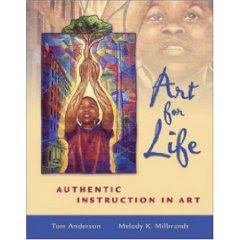Formalism and Its Discontents by Edmund Burke Feldman
Formalism and Its Discontents
Author(s): Edmund Burke Feldman
Source: Studies in Art Education, Vol. 33, No. 2 (Winter, 1992), pp. 122-126
Published by: National Art Education Association
Stable URL: http://www.jstor.org/stable/1320360
Accessed: 08/08/2009 14:32
Pedagogical formalism: the doctrine that the ultimate focus of aesthetic attention and critical meaning is, or ought to be, organization and presentation of the visual elements of works of art: line, shape, color, texture, mass, space, volume, and pattern
The Seductiveness of Formalism: Visual elements are teachable
-we begin instruction with the optically irreducible constituents of visual art
-we recognize art as an independent language, an autonomous mode of communication and expression that does not rely on the prior existence of words
-instruction moves from easy to difficult, simple to complex, and surface to depth
-academic respectability through instruction in visual grammar and syntax
-formalist doctrine has relevance both to making one's own art and seeing the art of others (flexibility)
-formalist doctrine gives even unsophisticated viewers access to the art of any time or place or people on the assumption that formal elements constitute a "lowest common denominator" of art regardless of material, technique, style, symbolism, social purpose, artistic intent, and cultural or historical context
Objections to Formalism
-From art historians:
-in the world's major art traditions, motives for creating and looking at art are rarely formalist
-formalists tend to ignore nonart contexts
-the preference of formalists for abstract and nonobjective art-art
-art historians have objections to formalism on the ground that it is almost wholly ahistorical, without a feeling for the influence of institutions and traditions in the creation and understanding of art.
-From aestheticians:
-separation of form from content is virtually impossible
-formalist art is nothing but art, it ignores the who, what, and why of our seeing
-evaluation of formal relationships in art cannot be carried out except on nonformalist grounds, that is, the social, moral, and ideological grounds that formalists disdain
-Social and political
-formalist art instruction demeans working-class and/or populist values and aspirations
-formalist art instruction teaches people that their spontaneous feelings and natural interests have little or no aesthetic validity
-aesthetic education has no future if it has to be built on a radical rejection of the experience of "most men."
- "impure" art (folk art, primitive art, commercial art, industrial art, and the so-called practical arts and crafts) support aesthetic values for reasons that are not confined to their formal qualities
Formalists prosper in education because they know a piece of the truth-that there is no art without form-but that piece of the truth, wrongly employed, turns into pedagogical abuse
Formalism is effective insofar as it encourages students to attend to "the facts" of form, but formalism is counter-productive insofar as it persuades students that art is always and only a matter of finding the abstract geometrical order hidden in every image
Prophylaxis
-in art there is no form without content and no content without form
-we cannot say of an artwork that its form is good while its meaning is bad
-formal elements should not be taught as abstract generalizations
-principles of formal organization or composition (unity, balance, rhythm) should be taught in connection with real works of art
-the role of visual context in determining meaning of any instance of form is important and should be learned early
-in criticism, one should move from visual context to social, religious, or economic contexts, not the other way around
-do not attempt social, religious, or political explanation of a work of art without prior formal analysis
-remember that formal relationships have nonformal significance
-think of formalist rhetoric as "dehydrated" talk about artistic images; a teacher's task is to add water that transmutes the dry rhetoric of formal-ism into fluent talk about life
-implementation of a multicultural art curriculum necessitates formalist instruction at the outset
-formal perception should be the beginning of a process of inquiry
Subscribe to:
Post Comments (Atom)






No comments:
Post a Comment